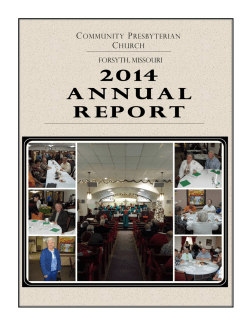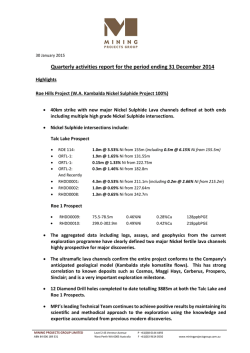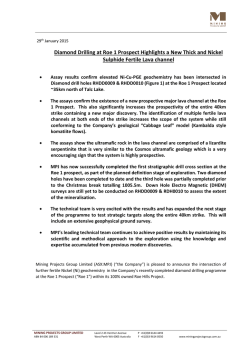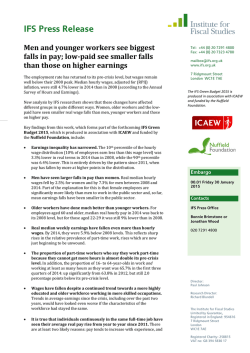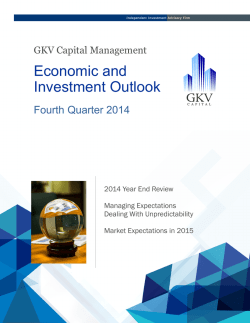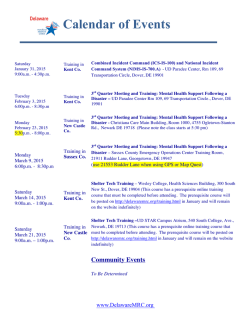
DKAM-final newsletter5-a - Donville Kent Asset Management Inc.
VOLUME XXX JANUARY 2015 INVESTMENT ISSUES • STRATEGIES • INSIGHTS FROM DONVILLE KENT Net Worth 2014 was another solid year for Canadian equity investors and a strong year for the Capital Ideas Fund. In 2014, the S&P/TSX Total Return Index rose 10.6%1 while the Capital Ideas Fund was up 22.7%2. In 2014, the key portfolio decisions we made were to be overweight knowledge-based industries (pharmaceuticals, software, IT services) and relatively underweight natural resource stocks. As most investors are aware, oil, along with most other commodities, nosedived in the second half of 2014. As we enter 2015, we have a few concerns. Both the US Dollar and oil have made massive moves in terms of price, and I expect that the effects of these moves have yet to be fully felt. In the coming months, the appreciation (US$) and depreciation (oil) of these two items will have a significant impact on earnings forecasts and employment in Canada and abroad. The exact winners and losers will become more obvious as the year unfolds. Until then, we are playing things a bit cautiously. As far as the positioning of the Capital Ideas Fund goes, we look relatively similar at the start of 2015 to the way we were in 2014, with the exception that we are relatively light on financial services companies. Natural resource and financial services companies make up roughly 70% of the TSX’s capitalisation, but at the time of this writing they make up less than 15% of the Capital Ideas Fund. So what then do we own? We currently have 23% of the fund in pharmaceutical companies and 43% in software and IT services companies. That said, we are looking at the oil and gas sector closely and our weightings in this sector will probably rise as the year moves forward. By the book Many people who read my newsletters recommend books that they think I might enjoy reading or that I might learn something from. And to those who do so, I only have two words to say: THANK YOU. I don’t read every book you recommend to me, but a few books that have caught my attention have been terrific. So once again, thank you for bringing them to my attention. The first book that was recommended to me is titled The Little Book That Builds Wealth by Pat Dorsey. This is an extremely well-written book that covers all of the major factors that drive competitive advantage in a company. Dorsey has a tight, crisp writing style and early in the book he identifies what an economic moat is and why it is so important. Dorsey is drawn to companies that can earn high returns on capital. As he points out, the strength of the economic moat will determine both how high the growth rate is and how long it will persist. In the first half of his book, Dorsey shows that companies that can earn above average returns for long periods of time are the ones that are protected in some way by brands, patents, economies of scale, etc. This in turn results in a strong, long-term growth profile, which allows for the magic of compounding. This, in my view, is the heart of long-term investing. Dorsey’s book describes this phenomenon better and more succinctly than just about any other book on this topic that I have read. The second half of Dorsey’s book is equally valuable and explains a simple process for looking at competitive advantage from a stock-picking perspective. His three step process is virtually identical to ours, and I believe it is extremely valuable to investors in picking the kinds of stocks that can compound over long periods of time. Those three steps, which are posed as questions, are summarised as follows; Step 1 – Has the firm historically generated solid returns on capital? Step 2 – Does the company have one or more of the competitive advantages described in Dorsey’s book? Step 3 – How strong is the company’s competitive advantage? Is it likely to last a long time or a relatively short time? If the goal of an active investor is first to identify a great company (and subsequently decide what an attractive price to pay for that company is), then one should view Dorsey’s three steps as the key starting place in deciding “what is a great company?” So how exactly does Dorsey go about this process? Just as we do at Donville Kent, Dorsey begins Step 1 by building a simple table that examines a company’s historical track record. In Dorsey’s simple table, he looks at the ten year track record of a company in the context of only four ratios: net margin (%), return on assets (%), financial leverage (x), and return on equity (%). This snapshot, he believes (and we agree), gives you a very quick but nonetheless, thorough first look at a company’s competitive position over a ROE REPORTER | DKAM 2 reasonably long period of time. I can’t reiterate enough how important this step is in identifying potentially great, high return on equity companies. So what do each of the metrics show us? Net margin gives us an idea of the trend in margins over time as well as the “fatness” of the margin. Both are excellent measures of whether a firm has a competitive advantage and if it is getting stronger, weaker, or is staying the same. Return on assets is his second metric. It shows us how profitable the company is on an unleveraged basis as well as showing us if the trend and returns on the company’s asset base are stable, improving, or deteriorating. Leverage shows us the ratio of assets to equity. The leverage ratio is more comprehensive than a simple net debt to capital ratio and it gives us an idea of how much the ROE is being lifted by leverage as opposed to margins. Finally, ROE is the “all in” number that gives us a quantitative measure of how competitive the company is in relation to its cost of equity and in comparison to other companies in which we might consider investing. ROE is also a superb measure of the growth of the net worth of the business and in our view a much better measure than either sales growth or EPS growth. At Donville Kent we view an ROE of 20% or better to be a superb level of competitive advantage and the threshold we target with our investments. Dorsey’s approach to identifying great companies by building a table with the historical track record of the company is really important. We have said before that once an investor does this, the great companies leap off the page and the mediocre companies become obvious. Steps 2 and 3 in Dorsey’s process are a little more challenging, because most investors do not have the time to undertake a thorough competitive analysis of a business. However, if you have completed Step 1 right, you are still way ahead of the average investor, as you have already screened out the poor and average companies from your possible choices. So how do we assess the competitive advantage of the company once we have generated a short list of potential investments? My recommendation is that you try to get a handle on a company’s products and services and use a book like Dorsey’s to ensure you have been as thorough as possible with your analysis. The trends in margins and ROE will give you some sense of where problems might arise. The rest is really the art of investing! The super allocators In 1962, long before Warren Buffett became a household name, he began acquiring shares in a small New England textile company called Berkshire Hathaway. By 1965, he controlled the company. While Berkshire stock was ROE REPORTER | DKAM 3 undervalued the company was far from a superb business, and by 1967, Buffett had already begun to allocate capital away from the textile business and into insurance and other businesses. The textile business never proved to be a good one, and by 1985 it was shutdown. But Buffett turned out to be a superb capital allocator, and while his textile business slowly died, Berkshire, under Buffett’s control, flourished. Today it is one of the largest and most profitable companies in the world. Buffett’s life as a capital allocator is well documented in William N. Thorndike, Jr’s book, The Outsiders, which features seven chapters on seven amazing CEO’s and an eighth chapter on Buffett. Like Buffett, many of these CEO’s found themselves early in their career running businesses that did not appear to have great “economic moats.” Thorndike shows how a series of capital allocation decisions slowly turned each of these businesses into compounding machines. Besides Berkshire, we hear the stories of Teledyne, Ralston Purina, General Cinema, TCI, and the Washington Post. Not all of these companies are household names, but in each case study there is a marvelous story of a CEO and management team who were focused on return on equity and delivered amazing results for their shareholders. I think Thorndike’s case studies highlight something I noticed many years ago. We sometimes encounter companies that don’t appear to have an easily identifiable competitive advantage yet manage to deliver returns on equity that are well above industry averages. I believe that the superior capital allocation skills of the CEO and management team are in many cases the key differentiating quality of the company. All of the companies and CEO’s that Thorndike writes about have this quality, which in my view illustrates just how powerful management can be on an otherwise ordinary business. Thorndike’s examples all come from the United States. Regrettably, no such book exists on great Canadian capital allocators. If such a book existed, I would love to see a chapter on Constellation Software (Mark Leonard), Paladin Labs (Jonathan Goodman), Home Capital (Gerry Soloway), and MTY Food Group (Stanley Ma). This is not an exhaustive list, but each of these CEO’s has been, and remains, a superb allocator of capital. This excellence is reflected in the share prices of the companies that they ran or continue to run. Pull out a long-term share price chart on any of these four companies and you will be astounded at what you see. Thorndike’s book is a valuable one for investors because, as the Buffett chapter aptly shows, the ability to intelligently allocate capital may be even more important than the competitiveness of a company’s products and services. The TSX is full of companies with competitive products and services that do not make an acceptable return on equity. Thus, an important conclusion is that great companies must have both competitive products and a ROE REPORTER | DKAM 4 management team than can astutely allocate capital. Such qualities are easy enough to describe, but in reality, a company that is strong in both areas is rare. An investment portfolio centred on management and competitive advantage Our fund is built around the ideas and concepts so adeptly addressed in Dorsey’s and Thorndike Jr.’s book. We are looking for companies that can earn an ROE of 20% per annum on a consistent basis. We believe these companies possess products that are highly competitive, deliver above average margins, and are run by management teams that work on keeping those products competitive. Those same managers have the added skill of being able to allocate capital intelligently so as to keep ROE’s high on a multi-year basis. In choosing each year’s short list of “great stocks to own” we start by screening through our database in pursuit of the 25 companies that have the best ROE’s in the country in the current year, while also boasting market caps in excess of $500mm. All of the data in the following figures is based on our adjustments. These include normalising all ROE’s for a company’s dividend policy and adding back amortization of intangibles to GAAP earnings to provide us with “cash earnings.” *return on average equity, based on cash earnings and adjusted for dividends ROE REPORTER | DKAM 5 Figure 1 shows us a list of fairly high-quality companies that we expect will deliver above average ROE’s in 2015. This list does not make any reference to valuation, and so before we dig in too far, we would like to know which companies are cheap and which are expensive before we do too much work. Figure 2 above takes the same list of companies and ranks them by their 2015 projected P/E ratios. The dispersion of forward P/E ratios ranges from Yellow Page’s 3.0x to Intertain Group’s 27.4x. In our view, none of these valuations is stratospheric but equally, the cheaper ones provide a certain margin of safety. In Figure 3 we combine our estimate for ROE and P/E to get a sense of which companies offer the most growth per unit of valuation (ROE divided by P/E). ROE REPORTER | DKAM 6 Five great stocks for 2015 Home Capital Group (HCG) – Toronto-based Home Capital is the largest independent Mortgage and Trust Company in Canada. The company has been run by Gerry Soloway for close to 30 years, and the company’s ROE has not fallen below 20% in more than 15 years. The company mitigates risk by using low leverage relative to other banks and trust companies and by focusing on loan-to-value mortgages. Home Capital is the seventh largest position in the Capital Ideas Fund. Figure 4 - Home Capital Group FYE Dec 2009A Rev ($MM) Cash Earnings ($MM) Cash EPS ($) Net margin (%) ROAE* Source: Donville Kent 277.6 145.4 2.11 52% 28% 2010A 2011A 2012A 2013A 2014E 2015E 308.8 181.0 2.61 59% 27% 361.3 190.8 2.75 53% 25% 422.7 228.7 3.30 54% 26% 481.2 264.4 3.80 55% 25% 562.6 309.2 4.39 55% 24% 658.2 346.2 4.91 53% 21% Constellation Software (CSU) – Toronto-based Constellation Software is run by the best management team in Canada. Constellation operates more than 200 best of breed software companies throughout Canada, the United States, and ROE REPORTER | DKAM 7 Europe that throw off a tremendous amount of cash. It has been growing at more than 30% per annum for the past five years. The company also boasts a strong balance sheet and significant employee ownership. Figure 5 - Constellation Software FYE Dec 2009A Rev ($MM) Cash Earnings ($MM) Cash EPS ($) Net margin (%) ROAE* Source: Donville Kent 437.9 70.8 3.35 16% 68% 2010A 2011A 2012A 2013A 2014E 2015E 634.0 97.9 4.62 15% 76% 773.3 158.8 7.49 21% 80% 891.2 177.8 8.39 20% 69% 1,210.8 212.2 10.02 18% 81% 1,710.5 261.7 12.35 15% 96% 1,980.5 345.7 16.31 17% 46% CGI Group (GIB.A) – CGI is a Montreal-based IT services company that operates throughout the world. The company routinely generates an ROE in excess of 20% per annum yet trades at a very reasonable 11.6x 2015 earnings. The company has been aggressively paying down debt over the past 24 months, and we suspect the company will make a significant acquisition in 2015, which should give it a nice jump in earnings in either 2015 or 2016. Figure 6 - Glentel CGI Group FYE Sep Rev ($MM) Cash Earnings ($MM) Cash EPS ($) Net margin (%) ROAE* Source: Donville Kent 2009A 2010A 2011A 2012A 3,825.2 451.6 1.47 12% 21% 3,732.0 506.9 1.78 14% 23% 4,223.9 574.6 2.17 14% 26% 4,772.5 486.2 1.58 10% 17% 2013A 2014A 2015E 10,084.6 10,499.7 10,805.6 988.2 1,179.5 1,281.0 3.21 3.82 4.12 10% 11% 12% 26% 26% 23% Badger Daylighting (BAD) – Calgary based Badger Daylighting is North America’s leading provider of non-destructive hydrovac excavation services. Badger traditionally works for contractors, engineers, and facility owners in the oil and gas, power, municipal, transportation, industrial and commercial construction industries. Badger has one of the most attractive ROE profiles amongst industrial companies in Canada. Figure 7 - Badger Daylighting FYE Dec 2009A Rev ($MM) Cash Earnings ($MM) Cash EPS ($) Net margin (%) ROAE* Source: Donville Kent 135.0 19.8 0.61 15% 30% 2010A 2011A 2012A 2013A 2014E 2015E 139.6 17.7 0.55 13% 25% 194.2 27.1 0.84 14% 33% 239.2 26.9 0.77 11% 23% 324.6 46.1 1.25 14% 30% 426.1 58.3 1.57 14% 30% 460.0 60.2 1.63 13% 22% ROE REPORTER | DKAM 8 Valeant Pharmaceuticals (VRX) – This Montreal-based multinational pharmaceutical company has a focus on branded, generic, and over-the-counter pharmaceutical products. The company has proven itself to be an astute acquirer as well as a strong grower and developer of its existing brands. Valeant management have shown themselves to be excellent allocators of capital, and we expect the company’s ROE to exceed 25% in 2015. Figure 8 - Valeant Pharmaceuticals FYE Dec 2009A Rev ($MM) Cash Earnings ($MM) Cash EPS ($) Net margin (%) ROAE* Source: Donville Kent 820.4 281.1 1.78 34% 22% 2010A 2011A 2012A 2013A 2014E 2015E 1181.2 11.6 0.06 1% 0% 2463.5 717.4 2.35 29% 16% 3480.4 812.9 2.66 23% 21% 5769.6 1035.8 3.10 18% 23% 8210.0 2307.4 6.88 28% 44% 9128.7 3370.2 10.05 37% 35% Final Thoughts I am quite happy with the way 2014 worked out, but don’t assume that I am getting complacent. I know a majority of the people who have invested in the fund and I take your trust very seriously. My pledge for 2015 and beyond is to grow your savings while doing my best to mitigate the risks that I can hedge. Thank you for your trust and support. I also wanted to say a quick thank you to Mike Scott and Sumit Mittal for recommending the two books I discussed earlier in the report. Finally, I want to say thank you to my team for another great year. They are, of course, Jordan, Ali, Jesse, Chris, and Dominika. I love coming to work each day, in part because I am surrounded by smart, intelligent, honest and hardworking people. Working with each of you is a real pleasure. Call me or write me if you want to chat – J.P. Donville [email protected] - 416-364-8886 1 2 markets.ft.com Time weighted rates of return for Class A Series 1, net of all fees and expenses ROE REPORTER | DKAM 9 DISCLAIMER Readers are advised that the material herein should be used solely for informational purposes. Donville Kent Asset Management Inc. (DKAM) does not purport to tell or suggest which investment securities members or readers should buy or sell for themselves. Readers should always conduct their own research and due diligence and obtain professional advice before making any investment decision. DKAM will not be liable for any loss or damage caused by a reader's reliance on information obtained in any of our newsletters, presentations, special reports, email correspondence, or on our website. Our readers are solely responsible for their own investment decisions. The information contained herein does not constitute a representation by the publisher or a solicitation for the purchase or sale of securities. Our opinions and analyses are based on sources believed to be reliable and are written in good faith, but no representation or warranty, expressed or implied, is made as to their accuracy or completeness. All information contained in our newsletters, presentations or on our website should be independently verified with the companies mentioned. The editor and publisher are not responsible for errors or omissions. Past performance does not guarantee future results. Unit value and investment returns will fluctuate and there is no assurance that a fund can maintain a specific net asset value. The fund is available to investors eligible to invest under a prospectus exemption, such as accredited investors. Prospective investors should rely solely on the Fund's offering documentation, which outlines the risk factors in making a decision to invest. The S&P/TSX Composite Total Return Index ("the index") is similar to the DKAM Capital Ideas Fund LP ("the fund") in that both include publicly traded Canadian equities of various market capitalizations across several industries, and reflect both movements in the stock prices as well as reinvestment of dividend income. However, there are several differences between the fund and the index, as the fund can invest both long and short, can utilize leverage, can take concentrated positions in single equities, and may invest in companies that have smaller market capitalizations then those that are included in the index. In addition, the index does not include any fees or expenses whereas the fund data presented is net of all fees and expenses. The source of the index data is S&P/Capital IQ. DKAM receives no compensation of any kind from any companies that are mentioned in our newsletters or on our website. Any opinions expressed are subject to change without notice. The DKAM Capital Ideas Fund, employees, writers, and other related parties may hold positions in the securities that are discussed in our newsletters, presentations or on our website. ROE REPORTER | DKAM 10
© Copyright 2025
